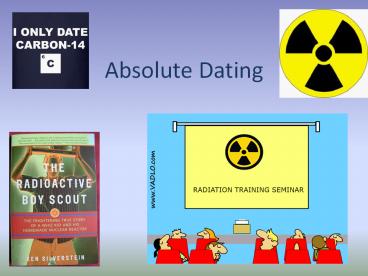Absolute Dating - PowerPoint PPT Presentation
1 / 29
Title: Absolute Dating
1
Absolute Dating
2
Absolute Dating Methods
Uses Radioactive Decay Sequences
1. Radioactive Isotopes change (decay) into
daughter isotopes at known rates.
2. Rates vary with the types of isotopes
Uranium, Carbon, etc.
3. Act as an atomic clock. We see the clock at
the end of its cyclelike watching a stopwatch
count down.
4. Allows for the assignment of Numerical Dates
to Rocks and Fossils.
3
What is radiation and what does it do?
4
Radiometric dating
Uses continuous decay to measure time since rock
formed
Only possible since late 1890s -- radioactivity
discovered in 1896
As minerals crystallize in magma they trap atoms
of radioactive isotopes in their crystal
structures
Radioactive isotopes will decay immediately and
continuously
As time passes, rock contains less parent and
more daughter
5
Chemistry Review What is a Radioactive Isotope?
Atom model
protrons atomic , defines the element
electrons
nucleus
protrons
neutrons
neutrons can vary isotopes
6
Radioactive isotopes
1. have nuclei that spontaneously decay
2. emit or capture subatomic particles
3. parent decaying radioactive isotope
4. daughter decay daughter
daughter
parent
loss or gain
5. The loss or gain of neutron converts parent to
daughter of same element
6. The loss or gain of proton changes parent into
entirely new daughter
7
3 primary ways of decay
alpha decay (Z 58)
beta decay (n0 p e-)
electron capture (e- p n0)
8
What about the RATE? (i.e. How Fast does an
element decay?)
To use the rate to determine age, we must
understand the concept of half-life.
9
Half-life
Amount of time it takes for half the atoms of the
parent isotope to decay
Regardless of isotope, the ratio of parent to
daughter atoms is predictable at each half-life.
10
Rate of Decay
11
Radioactive Decay Rates are Exponential! (not
Linear)
exponential
linear
Exponential decay never goes to zero
12
Radioactive Isotopes
Radioactive Isotopes
analogous to sand in an hour glass
As more sand flows out, you have less parent
and more daughter sand. Only here each set of
sand is a different element.
100
Parent
Parent
parent remaining
Daughter
Daughter
50
25
13
time-----------gt
13
Five Common Radioactive Isotope Pairs
Five Radioactive Isotope Pairs
Effective
Minerals and
Dating Range
Isotopes
Half-Life
of Parent
Rocks That Can
(Years)
Parent
Daughter
(Years)
Be Dated
Uranium 238
Lead 206
4.5 billion
10 million to
Zircon
4.6 billion
Uraninite
Uranium 235
Lead 207
704 million
Muscovite
Thorium 232
Lead 208
14 billion
48.8 billion
Biotite
Potassium feldspar
Rubidium 87
Strontium 87
4.6 billion
10 million to
Whole metamorphic
4.6 billion
or igneous rock
Potassium 40
Argon 40
1.3 billion
100,000 to
Glauconite
4.6 billion
Muscovite
Biotite
Hornblende
Whole volcanic rock
14
Example Uranium 238 decay to Lead 206 (stable)
15
Most common Radioactive dating systems
1. uranium-thorium-lead dating (previous
example)
U-238, U-235, Th-232 each of these decays
through a series of steps to Pb
U-238 to Pb-206 half-life 4.5 by U-235 to
Pb-207 half-life 713 my Th-232 to
Pb-208 half-life 14.1 my
2. potassium-argon dating
argon is a gas--may escape (ages too
young--daughter missing)
K-40 to Ar-40 half-life 1.3 by
3. rubidium-strontium dating
Rb-87 to Sr-87 half-life 47 by
16
4. What about carbon dating?
17
Radiocarbon Dating
Carbon-14 dating is based on the ratio of C-14 to
C-12 in an organic sample.
Living things take in three isotopes of carbon
Carbon 12 and 13 are stable, but carbon 14 is not
Carbon 14 has a half-life of 5730 years
When the organism dies, the clock starts.
(C-14 begins to decay to N-14)
Valid only for samples that are less than 70,000
years old (not useful for most rocks)
Method can be validated by cross-checking with
ice cores and tree rings
18
Carbon 14 Cycle
19
Correlation Cross-checking dating techniques
How do we check our readings and correlate from
different sources?
Absolute Dating Techniques are cross-checked
using
1. Ice Coresup to 70,000 years old
2. Dendrochronologyabout 14,000 years (recent
samples only)
3. Stratigraphyrock layers of known formation
rates and types
20
Ice Cores?
21
Some Ice core drill sites in Greenland
22
How are ice cores sampled?
Samples are examined using various light sources
for particle types and ice dynamics
23
What do we get from ice cores?
1. Climate information Paleoclimatology.
Temperature changes
Precipitation changes
Air Particulates counts/typesincluding carbon,
dust, bacteria, algae
2. Atmospheric Composition (Paleoatmospheric
studies)what gases were in the atmosphere in the
past and at what levels?
3. Solar Activity (i.e. by the algae, bacteria
and particulate types)
24
More recent events? Use Dendrochronology
25
Tree Ring Dating Method
26
Cross-checking Stratigraphy of Vertical Layers
Stratigraphylarge undisturbed layers of
rocks/fossils are laid down in sequential order.
(Law of Superposition)
Some Layers of iron-bearing igneous rocks can be
correlated by their magnetic properties based on
the Earths periodic reversal of magnetic poles!
(like Seafloor Spreading)
27
What about Horizontal or Diagonal section layers?
We use Walther's Law
The vertical sequence is repeated by the
horizontal
sequence
walking from A to B to C to the Coast you would
encounter the
-
rocks that would be encountered by drilling a
core into the
earth at any point (A, B, or C)
28
Basic Geochronological assumptions
- 1. Decay rates are constant through geological
time
Good reasons to believe that this is correct
from nuclear physics
Measurements of decay sequences in ancient
supernovae yield the same values as modern lab
measurements
2. The system is closed to adding or subtracting
of parent/daughter isotopes
Isotopic system and type of mineral are
important.
Careful procedure is essential to correct
analysis
- The type of rock used for dating is well known.
Igneous rocks are most reliable for absolute
dating.
Metamorphism may cause loss of daughter
products
Sedimentary rocks will give ages of the source
rocks
29
(No Transcript)































